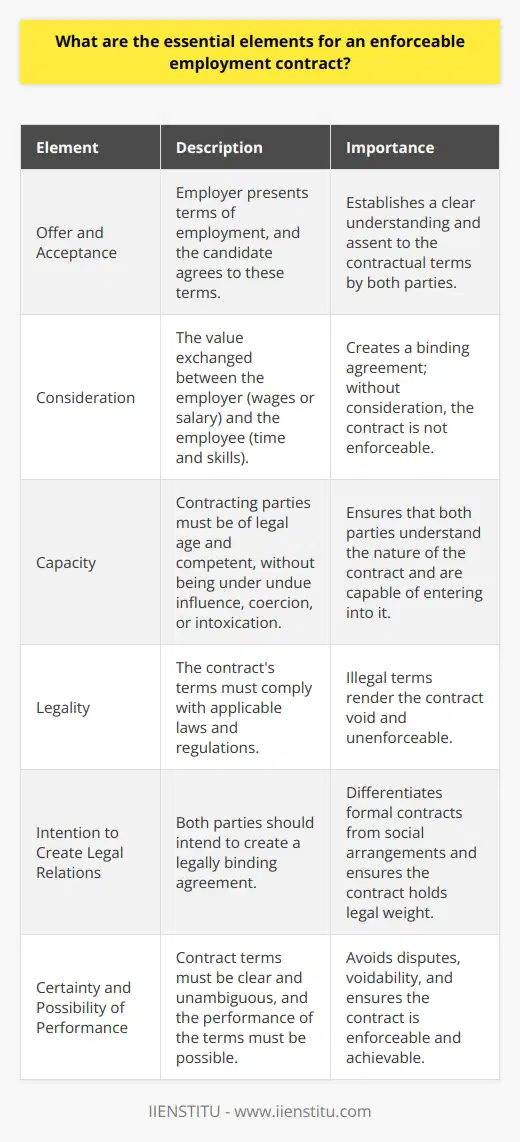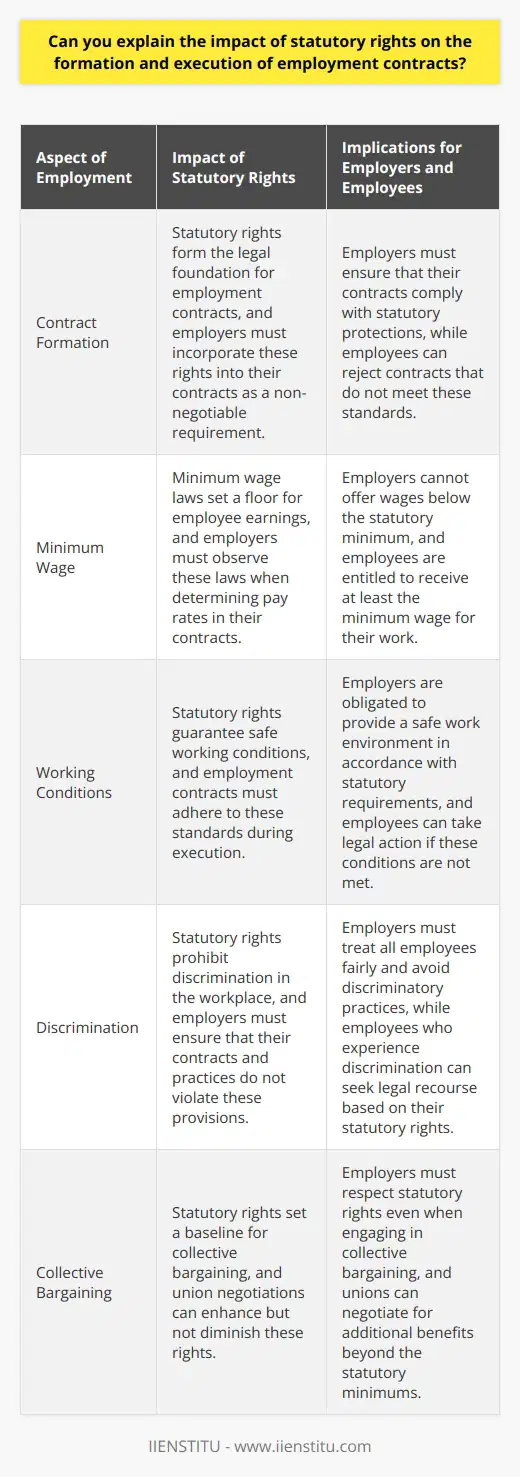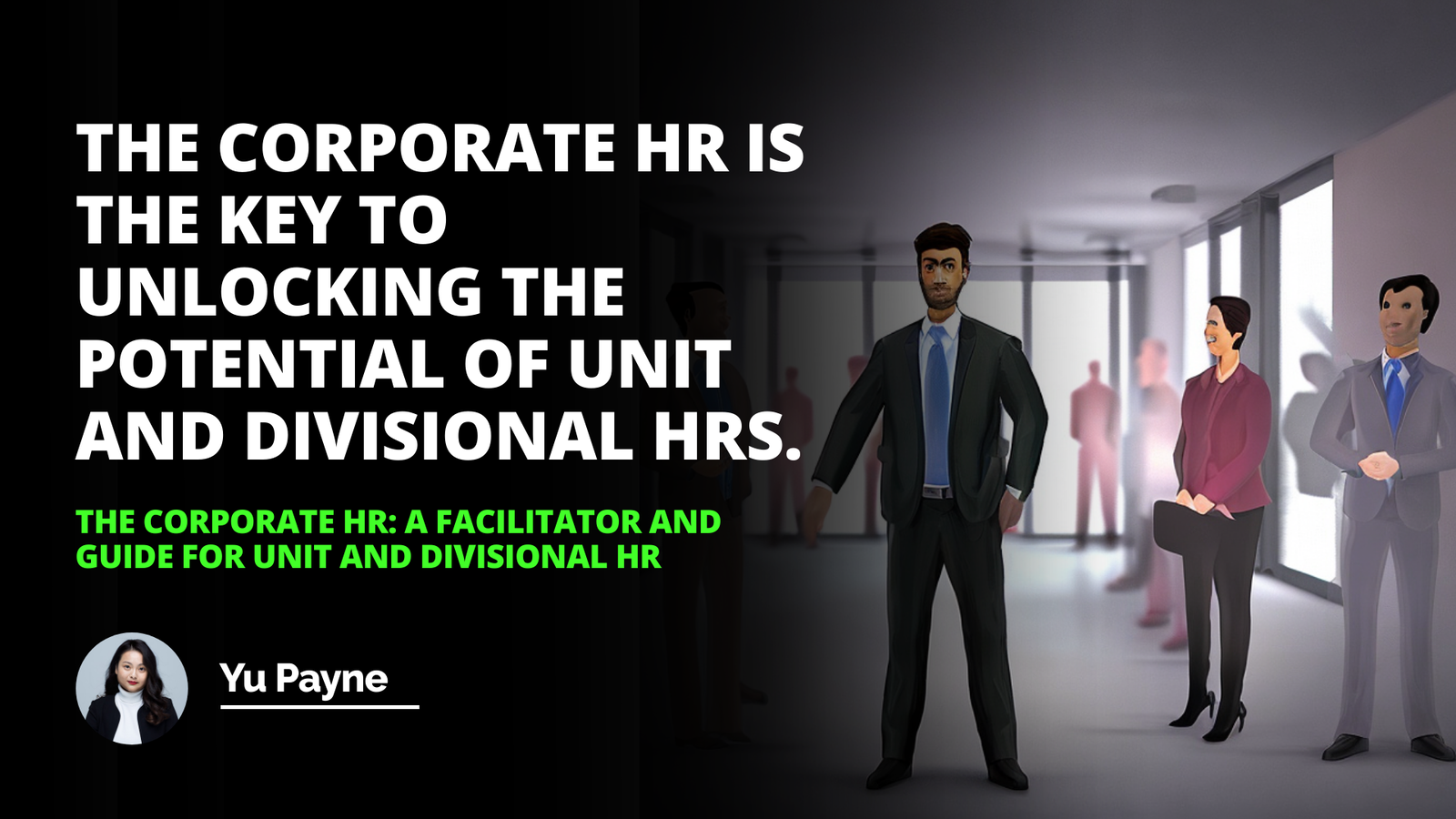
As someone who has been in the workforce for over a decade, I've come to realize the paramount importance of thoroughly understanding employment contracts. In my early career days, I admit to having skimmed through the fine print, eager to start my new job. However, as I navigated various roles and companies, I learned the hard way that not paying attention to the details of my contract could lead to misunderstandings and even legal disputes.
In today's rapidly evolving work landscape, where remote work, freelancing, and contract-based employment are becoming increasingly common, having a solid grasp of employment contracts is more crucial than ever. Whether you're a seasoned professional or just entering the job market, taking the time to comprehend the terms and conditions of your employment can save you from a world of trouble down the line.
The Role of Employment Contracts
An employment contract is not just a piece of paper; it's a legally binding document that outlines the rights, responsibilities, and expectations of both the employer and the employee. It serves as a roadmap for your professional relationship, detailing everything from your job duties and compensation to termination clauses and non-compete agreements.
I remember my first full-time job out of college. I was thrilled to have landed a position at a prestigious marketing firm and didn't think twice before signing my contract. It wasn't until a few months later, when I was asked to work overtime without additional pay, that I realized I hadn't thoroughly read the section on work hours. Had I taken the time to understand the terms of my contract, I could have negotiated better conditions or looked for a job that better aligned with my expectations.
The Importance of Clarity and Transparency
One of the key reasons employment contracts are so important is that they provide clarity and transparency for both parties involved. A well-drafted contract should leave no room for ambiguity or misinterpretation. It should clearly state the employee's job title, responsibilities, salary, benefits, and any other relevant terms of employment.
I once worked for a startup that was acquired by a larger company. During the transition, there was a lot of confusion around job roles and reporting structures. Many of my colleagues were unsure about their new responsibilities and felt that their original contracts were no longer valid. This experience taught me the importance of having an updated contract that clearly outlines any changes in employment terms, especially during company mergers or acquisitions.
Key Components of an Employment Contract
1. Job Description and Responsibilities
A detailed job description is one of the most crucial components of an employment contract. It should outline the specific duties and responsibilities associated with the role, as well as any expectations around work hours, travel, or overtime.
I've had the opportunity to hire several team members throughout my career, and I've always made sure to include a comprehensive job description in their contracts. Not only does this help set clear expectations from the start, but it also protects the company from potential legal issues down the line.
2. Compensation and Benefits
Another essential element of an employment contract is the compensation and benefits package. This should include details around base salary, bonuses, stock options, health insurance, retirement plans, and vacation time.
It's important to thoroughly review this section of your contract and ask questions if anything is unclear. I once accepted a job offer without realizing that the company had a very limited vacation policy. As someone who values work-life balance, this was a major drawback for me and ultimately led me to seek other opportunities.
3. Termination Clauses
No one likes to think about the possibility of losing their job, but it's crucial to understand the termination clauses in your employment contract. These clauses outline the circumstances under which either party can end the employment relationship, as well as any notice periods or severance pay requirements.
I've had friends who were blindsided by sudden layoffs and didn't receive the severance pay they were entitled to because they hadn't properly reviewed their contracts. On the flip side, I've also known people who were able to negotiate better severance packages because they had a clear understanding of their contractual rights.
Navigating Legal Aspects of Employment Contracts
1. Non-Compete Agreements
Non-compete agreements are becoming increasingly common in employment contracts, especially for high-level executives or employees with access to sensitive company information. These agreements prohibit employees from working for a competitor or starting a competing business for a certain period of time after leaving the company.
As someone who has signed non-compete agreements in the past, I can attest to the importance of carefully reviewing these clauses before signing. It's crucial to understand the scope and duration of the agreement and to consider how it may impact your future career prospects.
2. Intellectual Property Clauses
If you work in a creative field or are involved in developing new products or technologies, your employment contract may include intellectual property clauses. These clauses outline who owns the rights to any work created during the course of your employment.
I once worked for a software company that required all employees to sign over the rights to any code they wrote, even if it was done outside of work hours. As a passionate programmer who enjoyed working on personal projects, this was a tough pill to swallow. Looking back, I wish I had negotiated more favorable terms or sought employment elsewhere.
3. Dispute Resolution Procedures
Despite best intentions, disputes can arise in any employment relationship. That's why it's important for employment contracts to include clear procedures for resolving conflicts, whether through mediation, arbitration, or legal action.
I once found myself in a dispute with a former employer over unpaid commissions. Because my contract didn't specify a clear dispute resolution process, the situation quickly escalated and ended up in court. It was a stressful and costly experience that could have been avoided had my contract included a more robust dispute resolution clause.
The Importance of Legal Review
Given the complexities and potential legal implications of employment contracts, it's always a good idea to have them reviewed by a qualified attorney before signing. A knowledgeable attorney can help you understand the terms of your contract, identify any red flags, and negotiate more favorable conditions if necessary.
In my experience, investing in legal review upfront can save you a lot of headaches and potential legal fees down the line. It's a small price to pay for the peace of mind that comes with knowing your rights and interests are protected.
Conclusion
Employment contracts may not be the most exciting aspect of starting a new job, but they are undoubtedly one of the most important. As someone who has learned the hard way about the consequences of not paying attention to contractual details, I cannot stress enough the importance of thoroughly reviewing and understanding your employment contract before signing on the dotted line.
In today's fast-paced and ever-changing work environment, having a clear and comprehensive employment contract is more critical than ever. Whether you're a freelancer, a remote worker, or a full-time employee, taking the time to understand your rights and responsibilities can help you navigate the complexities of the modern workplace with confidence and clarity.
So the next time you're presented with an employment contract, don't just skim the surface. Take a deep dive into the details, ask questions, and seek legal counsel if necessary. Your future self will thank you for it.
Frequently Asked Questions
What are the essential elements for an enforceable employment contract?
Essential Elements of an Enforceable Employment Contract
Creating an enforceable employment contract requires understanding its key components. These elements must be present. They determine the contract's validity. Employers and employees both need this certainty.
Offer and Acceptance
An employment contract starts with an offer. An employer presents terms of employment. A potential employee considers these terms. Acceptance occurs when the candidate agrees. Both parties must clearly understand the offer's content. They must assent to the contractual terms.
Consideration
Consideration is a fundamental element. It represents the value exchanged. Employers offer wages or salary. Employees commit their time and skills. Such exchange creates a binding agreement. No consideration, no enforceable contract.
Capacity
Contracting parties must possess the legal capacity. They must understand the contract's nature. This implies a certain age. Typically, they must be adults. Competency is another aspect. Parties should not be under undue influence. Coercion or intoxication affects capacity.
Legality
The contract's substance must be legal. Employment terms cannot contravene laws or regulations. Illegal terms render the contract void.
Intention to Create Legal Relations
Both parties should intend to make a legally binding agreement. This intention differentiates social arrangements from formal contracts. Without this mutual intention, the contract holds no legal weight.
Certainty and Possibility of Performance
Contracts must have clear terms. Ambiguity can lead to disputes or void agreements. Performance of the contract's terms must be possible. Unachievable terms cannot constitute an enforceable contract.
Employment contracts often include additional elements:
- Job description: Clarifies duties and expectations.
- Duration of employment: Specifies contract length, including start and end dates.
- Compensation details: Outlines wages, salary, bonuses, and benefits.
- Confidentiality clauses: Protects sensitive information.
- Non-compete clauses: Limits future employment opportunities.
Understanding these elements can help ensure a contract's enforceability. It provides a framework for clear expectations and obligations. It can protect both employers and employees. Always consult a legal professional for detailed guidance.

How does the law enforce compliance with employment contracts?
Employment Contracts and the Law
Employment contracts bind employers and employees. They outline mutual obligations. These agreements serve as operational guidelines. However, issues may arise. Compliance becomes a critical concern.
Legal Mechanisms Ensure Compliance
The law employs multiple mechanisms. These enforce contract adherence. First, there are laws. Laws set employment standards. They guarantee minimum conditions. Employers must observe these.
Courts resolve disputes. They interpret contract terms. Courts assess breaches as well. Parties submit evidence. Judges deliver rulings based on this evidence. Verdicts may include remedies. These typically encompass damages. Sometimes they impose injunctions.
Arbitration offers an alternative. It's a private dispute resolution method. Parties select the arbitrator. This person acts like a judge. They render binding decisions. Arbitration can be swifter than court. It's often more confidential as well.
Mediation represents another avenue. It involves a neutral third party. This mediator facilitates negotiations. They help find mutually agreeable solutions. Mediation remains non-binding until parties agree.
Labor departments implement oversight. They ensure legal compliance. These departments can inspect workplaces. They also investigate complaints. They can impose penalties. These might include fines.
Unions play a role too. They advocate for workers. They monitor contract execution. Unions can negotiate. They can strike or picket. These actions pressure employers.
Employees have direct actions available. They can raise concerns. They can document breaches. They can submit grievances. Their active participation is vital.
Remedies for Breach of Contract
Breaches lead to specific remedies. Each aims to rectify wrongs.
- Compensatory damages reimburse losses.
- Restitution aims to restore original positions.
- Specific performance mandates contractual duties.
- Injunctions prohibit certain actions.
Awareness of these mechanisms matters. Understanding deters potential breaches. It encourages compliance.
In conclusion, the law offers robust tools. They ensure agreement adherence. Contractual breaches face serious repercussions. This framework maintains order in employment relations.

Can you explain the impact of statutory rights on the formation and execution of employment contracts?
Understanding the Role of Statutory Rights in Employment
Statutory Rights Shape Contracts
Statutory rights form a legal bedrock. They underpin employment contracts. Lawmakers design these rights to protect workers. Employers must incorporate them into their contracts. This is non-negotiable. Contracts cannot undercut statutory protections. For example, minimum wage laws set earnings floors. Employers must observe them.
Statutory Guarantees Impact Execution
Employment contracts live within legal frameworks. Statutory rights guide their execution. Both parties need awareness of these rights. The rights ensure fair treatment. They also guarantee safe working conditions. Contract deviations can trigger legal consequences.
Rights Impose Employer Duties
Statutory rights dictate employer responsibilities. These duties range wide. They cover pay, hours, and discrimination. Employers bear these obligations. Compliance is mandatory, not optional. Employment terms must respect statutory minimums.
Considerations For Employees
Employees benefit from statutory protections. Awareness grants them power. They can advocate for fair treatment. Knowledge of these rights is key. It helps in spotting contract discrepancies. Employees can reject contracts that do not comply.
The Interplay With Collective Bargaining
Statutory rights may interact with union negotiations. They set a baseline for bargaining. Collective agreements may enhance but cannot diminish statutory rights. This ensures consistent minimum protections.
Effects On Contract Variability
Statutory rights limit contract variability. They impose consistency across the workplace. Contract diversity persists but within legal bounds. Businesses must navigate these restrictions. They must harmonize contractual terms with statutory requirements.
The Bottom Line
Statutory rights are non-negotiable. They influence contract formation and execution significantly. They protect employees. They standardize employment practices. They preserve workplace fairness and safety. Contracts must align with statutory provisions. This balance supports both individual and collective employment relations.



